![]()
![]()
![]()
Use LEFT and RIGHT arrow keys to navigate between flashcards;
Use UP and DOWN arrow keys to flip the card;
H to show hint;
A reads text to speech;
24 Cards in this Set
- Front
- Back
|
Organisms are named and arranged into taxa
Providing: Universal names Reference Facilitating research, scholarship, and communication |
Organisms are named and arranged into __________
Providing: Universal __________ __________ Facilitating __________, __________, and __________ |
|
|
Phylogeny provides tools for clarifying evolution of organisms as well as their interrelationships
|
__________ provides tools for clarifying __________ of organisms as well as their __________
|
|
|
All Species Inventory 2001 - 2025
There are 10-100 million estimated species and only 2.5 million inventoried so far. |
All Species Inventory 2001 - __________
There are __________ million estimated species and only __________ million inventoried so far. |
|
|
The scientific name of a species comes from the genus and the specific epithet.
|
The scientific name of a species comes from the __________ and the __________.
|
|
|
Carlous Lennaeus started the 2 Kingdom system in 1735, the Plant and Animal Kingdoms.
In 1857 bacteria & fungi were put into the Plant Kingdom. Ernst Haeckel added the Protista Kingdom in 1866. In 1959 the Fungi Kingdom was added. In 1969 Robert Whittaker created 5 Kingdoms: Plantae, Animalia, Fungi, Protista, Monera. Carl Woese created the 3 domain Kingdom in 1978. Eukarya, Bacteria, and Archaea were based on variation in cellular composition supported primarily on evidence from rRNA differences. |
__________ started the 2 Kingdom system in __________, the __________ and __________ Kingdoms.
In __________, __________& __________ were put into the Plant Kingdom. __________ added the __________ Kingdom in __________. In __________ the __________ Kingdom was added. In __________, __________ created 5 Kingdoms: __________, __________, __________, __________, __________. __________ created the 3 domain Kingdom in __________. __________, __________, and __________were based on variation in __________ supported primarily on evidence from __________ differences. |
|
|
Prokaryote term introduced in 1937.
In 1961 the current definition of prokaryote introduced. It is a single organism with no nuclear membrane isolating their DNA. |
Prokaryote term introduced in __________.
In __________ the current definition of prokaryote introduced. It is a single organism with __________ isolating their __________. |
|
|
Eukaryotic species is based biological species concept which is based on mating behavior.
Populations of eukaryotic species are closely related group of organisms that breed and produce fertile offspring. |
Eukaryotic species is based __________ which is based on __________ behavior.
Populations of eukaryotic species are closely related group of organisms that __________ and produce __________. |
|
|
Prokaryotic species are a population of cells with similar characteristics.
Clone is an exact copy while a strain is a variation from the wild type or mutation. |
Prokaryotic species are a population of __________ with similar __________.
__________ are an exact copy while a __________ is a variation from the __________ or __________. |
|
|
Viral species are a group of viral particles with similar characteristics that occupy the same ecological niche.
|
Viral species are a group of __________ with similar __________ that occupy the same __________.
|
|
|
Bergey's Manual of Determinative Bacteriology
Provides identification schemes for identifying bacteria and archaea. Morphology Differential staining Biochemical tests |
Bergey's Manual of __________ Bacteriology
Provides identification schemes for identifying bacteria and archaea. __________ __________ __________ |
|
|
Bergey's Manual of Systematic Bacteriology
Provides phylogenetic information on bacteria and archaea Based on rRNA sequencing |
Bergey's Manual of __________ Bacteriology
Provides phylogenetic information on bacteria and archaea __________ |
|
|
Approved Lists of Bacterial Names
Lists species of known prokaryotes Based on published articles |
Approved Lists of Bacterial Names
__________ __________ |
|
|
Methods of Identifying Microorganisms
1. Morphological characteristics 2. Differential and structural stains 3. Biochemical tests 4. Serology - based on antigenic nature of microbes 5. Phage typing - determines to which phages a bacteria is susceptible 6. Analysis of nucleic acids |
Methods of Identifying Microorganisms
1. __________ characteristics 2. __________ and __________ stains 3. __________ tests 4. __________ - based on __________ nature of microbes 5. __________ typing - determines to which __________ a __________ is susceptible 6. Analysis of __________ |
|
|
Biochemical tests for identifying microorganisms are based on enzyme activity.
|
__________ tests for identifying microorganisms are based on __________.
|
|
|
Analysis of nucleic acids
DNA base composition uses C + G ration pairing. DNA fingerprinting using electrophoresis of RFLPs Nucleic acid hybridization rRNA sequencing PCR |
Analysis of __________
__________ composition uses __________ ration pairing. DNA __________ using __________ of RFLPs __________ hybridization __________ sequencing __________ |
|
|
ELISA is enzyme linked immunosorbent assay
|
ELISA is __________
|
|
|
Slide agglutination tests combines unknown bacteria with a known antiserum.
|
__________ combines unknown __________ with a known __________.
|
|
|
Western blotting uses gel electrophoresis to determine bacteria or virus types.
|
__________ uses __________ to determine __________ or __________ types.
|
|
|
.
|
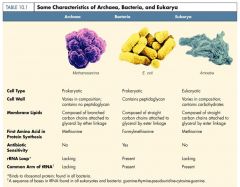
|
|
|
.
|
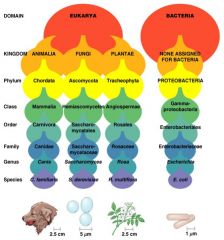
|
|
|
.
|
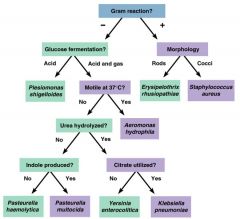
|
|
|
rapid identification
|
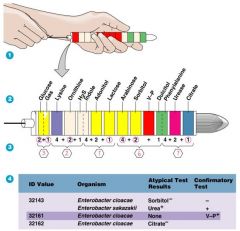
|
|
|
phage typing
|
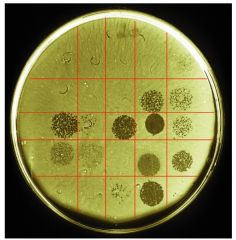
|
|
|
nucleic hybridization
|
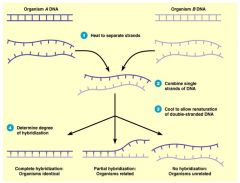
|

